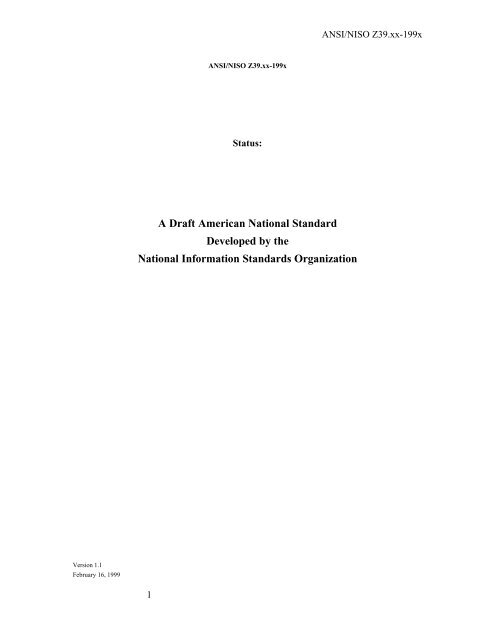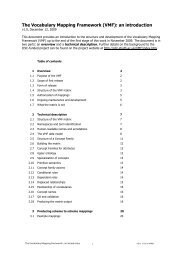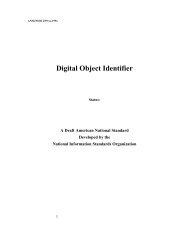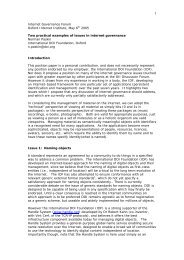A Draft American National Standard Developed by the ... - DOIs
A Draft American National Standard Developed by the ... - DOIs
A Draft American National Standard Developed by the ... - DOIs
You also want an ePaper? Increase the reach of your titles
YUMPU automatically turns print PDFs into web optimized ePapers that Google loves.
ANSI/NISO Z39.xx-199xANSI/NISO Z39.xx-199xStatus:A <strong>Draft</strong> <strong>American</strong> <strong>National</strong> <strong>Standard</strong><strong>Developed</strong> <strong>by</strong> <strong>the</strong><strong>National</strong> Information <strong>Standard</strong>s OrganizationVersion 1.1February 16, 19991
ANSI/NISO Z39.xx-199xAbout NISO <strong>Draft</strong> <strong>Standard</strong>sThis is a draft standard and subject to change. To learn <strong>the</strong> current status of thisproposed standard contact <strong>the</strong> NISO Office: 4733 Be<strong>the</strong>sda Avenue, Suite 300, Be<strong>the</strong>sda, MD20814 USA; Telephone: 301-654-2512; Fax: 301-654-1721; Internet nisohq@niso.org.NISO standards are developed <strong>by</strong> <strong>the</strong> <strong>Standard</strong>s Committees of <strong>the</strong> <strong>National</strong>Information <strong>Standard</strong>s Organization. A rigorous review process includes offering each NISOvoting member and o<strong>the</strong>r interested parties an opportunity to review <strong>the</strong> proposed standard. Inaddition, approval requires verification <strong>by</strong> <strong>the</strong> <strong>American</strong> <strong>National</strong> <strong>Standard</strong>s Institute that itsrequirements for due process, consensus, and o<strong>the</strong>r criteria for approval have been met <strong>by</strong>NISO; NISO standards thus also become <strong>American</strong> <strong>National</strong> <strong>Standard</strong>s.This standard may be revised or withdrawn at any time. Purchasers may receivecurrent information on all NISO standards <strong>by</strong> calling or writing <strong>the</strong> <strong>National</strong> Information<strong>Standard</strong>s Organization.©1997 <strong>National</strong> Information <strong>Standard</strong>s OrganizationThis draft standard may be photocopied for noncommercial purposes to facilitate <strong>the</strong> reviewand approval process.Address inquiries to NISO, 4733 Be<strong>the</strong>sda Avenue, Suite 300, Be<strong>the</strong>sda, MD 20814;nisohq@niso.org; Telephone: 301-654-2512; Fax: 301-654-1721.To Order Any NISO <strong>Standard</strong> Contact:NISO Press Fulfillment, P.O. Box 338, Oxon Hill, MD 20750-0338 USATelephone: 1-800-282-6476 or 301-567-9522Version 1.1February 16, 19992
ANSI/NISO Z39.xx-199xContentsForewordBackgroundGoals of Syntax CommitteeElements of <strong>the</strong> DOI and MetadataThe DOI in Context (DOI System, Handle System, IDF)Character Set Issues1. Introduction1.1 Purpose1.2 Scope2. <strong>Standard</strong>s and References2.1 Referenced <strong>Standard</strong>s3. Definitions4. Format and Characteristics of <strong>the</strong> DOI4.1 Prefix4.2 Suffix5. Maintenance AgencyAPPENDIX AAPPENDIX BDesignation of Maintenance AgencyAPPENDIX CExamplesAPPENDIX DRelated <strong>Standard</strong>s and ReferencesSecondary <strong>Standard</strong>sReferences to <strong>Standard</strong>s in Development:References:APPENDIX EApplication IssuesEncoding RequirementsEncoding CharactersMandatory/Recommended EncodingTable 1 – Mandatory EncodingTable 2 – Recommended EncodingVersion 1.1February 16, 19993
ANSI/NISO Z39.xx-199xForewordThis Foreword is not part of <strong>the</strong> <strong>American</strong> <strong>National</strong> <strong>Standard</strong> for <strong>the</strong> Digital Object Identifier(DOI), ANSI/NISO Z39.xx-199x. It is included for information only.This standard defines <strong>the</strong> syntax for <strong>the</strong> Digital Object Identifier (DOI). The Digital ObjectIdentifier (DOI) system is an identification system for intellectual property in <strong>the</strong> digitalenvironment. <strong>Developed</strong> <strong>by</strong> <strong>the</strong> International DOI Foundation on behalf of <strong>the</strong> publishingindustry, its goals are to provide a framework for managing intellectual content includingactivities such as linking users with content owners, facilitating electronic commerce, andenabling automated copyright management.BackgroundSome history on <strong>the</strong> development of this draft standard is needed to understand how and why<strong>the</strong> draft standard appears in its present form.DOI System BackgroundThe Internet is a new environment for information transactions, and requires new enablingtechnologies to provide services and to protect intellectual property. Systems must bedeveloped to identify, au<strong>the</strong>nticate, and protect content to insure that what <strong>the</strong> user isrequesting is what is being delivered. At <strong>the</strong> same time, <strong>the</strong> rights owner of <strong>the</strong> informationmust be sure that copyright in content is respected and protected.In considering <strong>the</strong> new systems required, international publishers realized that a first step wouldbe <strong>the</strong> development of an identification system to be used for intellectual property in <strong>the</strong> digitalenvironment. Such a system was launched at <strong>the</strong> Frankfurt Book Fair in October 1997: <strong>the</strong>Digital Object Identifier (DOI) system provides a unique identification mechanism for contentin all media, and also a way to link users of <strong>the</strong> materials to <strong>the</strong> rights holders or <strong>the</strong>ir agents tofacilitate automated digital commerce.NISO Involvement and Role of <strong>the</strong> International DOI Foundation (IDF)The ongoing management of <strong>the</strong> DOI System is handled <strong>by</strong> an international, not-for-profit,membership-based organization called <strong>the</strong> International DOI Foundation with offices in <strong>the</strong>United States and Geneva, Switzerland. The Foundation is responsible for licensing DirectoryManagers/Registration Agencies and technology providers, for setting policy for <strong>the</strong> system,and for encouraging development of <strong>the</strong> related enabling technologies to build <strong>the</strong>infrastructure for electronic transaction systems such as copyright management.Though <strong>the</strong> DOI System was originally developed <strong>by</strong> <strong>the</strong> publishing industry, it was recognizedthat <strong>the</strong> DOI system would have a broader scope and that it should work with establishedstandard bodies as much as possible. ANSI/NISO involvement was requested in early 1998 inorder to recognize <strong>the</strong> broader potential use of a digital object identifier, and it was decided todevelop a standard for <strong>the</strong> syntax of <strong>the</strong> DOI identifier string.Version 1.1February 16, 19994
ANSI/NISO Z39.xx-199xGoals of Syntax CommitteeThe standards subcommittee was established with <strong>the</strong> following goals:*Formalize <strong>the</strong> syntax for <strong>the</strong> DOI identifier string to enable DOI registration.It has been possible to register <strong>DOIs</strong> since 1998 but <strong>the</strong>re has been concern that <strong>the</strong> syntaxhas not been conclusively set.*Determine <strong>the</strong> elements of <strong>the</strong> DOI identifier string.Several proposals to add elements to <strong>the</strong> DOI identifier string had been proposed and <strong>the</strong>subcommittee was tasked to determine which ones should be included in <strong>the</strong> string.*Limit <strong>the</strong> scope of <strong>the</strong> standard to <strong>the</strong> DOI identifier string.The DOI system is made up of a number of parts including <strong>the</strong> identifier string, <strong>the</strong>resolution mechanism, and <strong>the</strong> Directory. This standard addresses only <strong>the</strong> syntax for <strong>the</strong>identifier string.While limiting itself to <strong>the</strong> DOI identifier string, <strong>the</strong> Syntax Committee took into account<strong>the</strong> wider context of <strong>the</strong> DOI system, <strong>the</strong> Handle system, <strong>the</strong> International DOIFoundation and <strong>the</strong> Internet. This Foreword and <strong>the</strong> Appendices provide importantinformation and references for understanding <strong>the</strong> DOI system, how <strong>the</strong> DOI is being used,how it relates to o<strong>the</strong>r standards and <strong>the</strong> Internet, and where to get more information.Elements of <strong>the</strong> DOI and MetadataFrom <strong>the</strong> earliest development of <strong>the</strong> Digital Object Identifier (DOI), one of <strong>the</strong> mostwidely discussed issues has been whe<strong>the</strong>r or not <strong>the</strong> identifier string of which <strong>the</strong> DOI iscomposed should be meaningful. The syntax of this string, as defined <strong>by</strong> this standard,contains a set of components of very limited meaning. They are as follows:Each DOI string begins with a code indicating that within <strong>the</strong> Handle System of <strong>the</strong>Corporation for <strong>National</strong> Research Initiatives (CNRI) <strong>the</strong> string will be resolved <strong>by</strong> <strong>the</strong>Local Handle System reserved for <strong>the</strong> DOI.The next component of <strong>the</strong> DOI string notes <strong>the</strong> prefix assigned to <strong>the</strong> DOI Prefix holderthat originally created <strong>the</strong> DOI. It should be noted that this prefix provides no informationabout current ownership of <strong>the</strong> object that <strong>the</strong> DOI string references.The final part of <strong>the</strong> DOI string contains an unspecified identifier.Thus, any particular DOI string contains no information about <strong>the</strong> object identified, and isin that sense meaningless. Because of this decision not to provide any information about<strong>the</strong> object referenced within <strong>the</strong> syntax of <strong>the</strong> DOI, <strong>the</strong> string will be of little use inisolation without accompanying information about <strong>the</strong> object identified. Such informationabout objects is called metadata and may be aggregated in metadata databases.Version 1.1February 16, 19995
ANSI/NISO Z39.xx-199xThe following recommendations are accordingly included here:1. No DOI string should be registered without an accompanying set of metadatadescribing <strong>the</strong> object being referenced in <strong>the</strong> syntax string.2. The DOI Syntax <strong>Standard</strong> Maintenance Agency should provide <strong>the</strong> latest informationabout <strong>the</strong> relevant metadata schemas and any databases that aggregate metadata aboutDOI referenced objects.The DOI in Context (DOI System, Handle System, IDF)The DOI System is an implementation of <strong>the</strong> Handle System, developed <strong>by</strong> <strong>the</strong> Corporationfor <strong>National</strong> Research Initiatives (CNRI). The DOI System is managed <strong>by</strong> <strong>the</strong> InternationalDOI Foundation, which sets policies, appoints service providers and ensures <strong>the</strong> successfuloperation of <strong>the</strong> System. The IDF has issued a document outlining <strong>the</strong> DOI issues entitled“Guidelines for <strong>the</strong> Issuance and Use of DOI” (<strong>the</strong> most current version will be available athttp://dx.doi.org/10.1000/25).Character Set IssuesThe Committee discussed character sets and decided that Unicode and UTF-8 will be usedin this standard. The SICI standard limited characters to 7-bit ASCII but <strong>the</strong> committeefelt that since <strong>the</strong> XML specification (Extensible Markup Language 1.0 -http://www.w3.org/TR/REC-xml ) and <strong>the</strong> underlying Handle technology (Internet<strong>Draft</strong> -- Handle System: A Persistent Global Naming Service - Overview and Syntax -http://hdl.handle.net/4263537/4006) support Unicode and UTF-8 (The UnicodeConsortium - http://www.unicode.org/) that <strong>the</strong> DOI Syntax should follow suit.The only reserved character in <strong>the</strong> DOI string is percent (%). Percent is used for hexencoding <strong>DOIs</strong> and <strong>the</strong>refore must always be hex encoded as %25. There are issues(addressed in Appendix E) concerning character encoding when using <strong>DOIs</strong> in URLs. Alongwith percent (%), space (SP), quotes (") and hash (#) must be encoded when <strong>the</strong>y are used inURLs or HTML pages. However, <strong>the</strong>re is no requirement for <strong>the</strong>m to be encoded whenregistering <strong>DOIs</strong> and <strong>the</strong>y are stored in <strong>the</strong>ir unencoded form in <strong>the</strong> DOI Directory.Users of ASCII should note that ASCII is UTF-8 compliant. Thus, <strong>DOIs</strong> consistingentirely of characters taken from <strong>the</strong> ASCII character set require no modifications orchanges (o<strong>the</strong>r than those detailed in Appendix E) in order to meet this standard'srequirement for Unicode and UTF-8 compliance.ASCII characters in <strong>the</strong> DOI string are case insensitive.Version 1.1February 16, 19996
ANSI/NISO Z39.xx-199xNISO Voting Members[list]NISO Board of Directors[list]<strong>Standard</strong>s Committee xxNISO acknowledges with thanks and appreciation <strong>the</strong> contributions of <strong>the</strong> followingpersons who served on NISO <strong>Standard</strong>s Committee xx that drafted <strong>the</strong> proposedstandards for <strong>the</strong> Digital Object Identifier syntax.[list]Version 1.1February 16, 19997
ANSI/NISO Z39.xx-199xDigital Object Identifier1. Introduction1.1 PurposeANSI/NISO Z39.xx-199x defines <strong>the</strong> syntax for a unique and persistent character string called<strong>the</strong> Digital Object Identifier (DOI).1.2 ScopeThis standard defines <strong>the</strong> syntax of <strong>the</strong> DOI character string, which is made up of a prefix andsuffix and is registered according to <strong>the</strong> requirements set <strong>by</strong> <strong>the</strong> International DOI Foundation(IDF). Policies governing <strong>the</strong> assignment and use of <strong>DOIs</strong> are determined <strong>by</strong> <strong>the</strong> IDF and areoutside <strong>the</strong> scope of this document.2. <strong>Standard</strong>s and ReferencesThe Referenced <strong>Standard</strong>s are those that are required to construct a DOI. Secondary<strong>Standard</strong>s and References includes citations to documents that can be of use in conjunctionwith <strong>the</strong> DOI.2.1 Referenced <strong>Standard</strong>sUnicode Consortium "The Unicode <strong>Standard</strong> Version 2.0" ISBN: 0-201-48345-9(http://www.unicode.org/)See Appendix C for related standards and references.3. DefinitionsDigital Object Identifier (DOI)A unique character string used in a system conforming to <strong>the</strong> rules of, and deposited in <strong>the</strong>directory administered <strong>by</strong>, <strong>the</strong> IDF.DirectoryA repository in which <strong>DOIs</strong> are deposited and attendant locations are maintained.Directory managerThe entity which controls <strong>the</strong> Directory.DOI prefixThe Directory and <strong>the</strong> Registrant codes issued <strong>by</strong> <strong>the</strong> Registration agency to a Registrantfor use as <strong>the</strong> prefix in <strong>the</strong> <strong>DOIs</strong> allocated <strong>by</strong> that Registrant.Version 1.1February 16, 19991
DOI suffixThe character string assigned <strong>by</strong> a Registrant. The suffix shall be unique within <strong>the</strong> rangeof <strong>DOIs</strong> specified <strong>by</strong> <strong>the</strong> DOI prefix held <strong>by</strong> <strong>the</strong> Registrant.International DOI Foundation (IDF)The body set up to support <strong>the</strong> needs of <strong>the</strong> intellectual property community in <strong>the</strong> digitalenvironment <strong>by</strong> establishing and governing <strong>the</strong> DOI System, setting policies for <strong>the</strong>System, appointing service providers for <strong>the</strong> System, and overseeing <strong>the</strong> successfuloperation of <strong>the</strong> System.Registration Agency [DOI registration agency]One of <strong>the</strong> agencies appointed <strong>by</strong> <strong>the</strong> International DOI Foundation to register andallocate DOI prefixes to Registrants, and which subsequently accepts <strong>DOIs</strong> beingdeposited <strong>by</strong> Registrants. A Registration Agency may also be a Directory Manager.RegistrantAn organization or entity that has requested and been allocated one or more DOI prefixes<strong>by</strong> a Registration Agency.DepositThe act of entering into <strong>the</strong> Directory a DOI and associated information necessary for <strong>the</strong>DOI to be used.RegistrationThe act of allocating <strong>the</strong> DOI prefix to a Registrant <strong>by</strong> <strong>the</strong> Registration Agency.4. Format and Characteristics of <strong>the</strong> DOIThe DOI is made up of <strong>the</strong> Prefix and <strong>the</strong> Suffix. Within <strong>the</strong> prefix are <strong>the</strong> Directory Code and <strong>the</strong> Registrant Code . The suffix is made up of <strong>the</strong> DOI Suffix String. See Appendix A for <strong>the</strong> allowed length of <strong>the</strong> DOI string and a statement on casesensitivity.The syntax of <strong>the</strong> DOI string is:. /Detailed explanations of each section of <strong>the</strong> DOI string follow.4.1 Prefix - Directory Code (required) –See Appendix A for all valid values for <strong>the</strong> Directory Code. The Maintenance Agency isVersion 1.1February 16, 19992
esponsible for updating <strong>the</strong> list of valid values. Registrant’s Code (required)Separated from <strong>by</strong> “.”. This is <strong>the</strong> number assigned to <strong>the</strong> registrant <strong>by</strong> <strong>the</strong> RegistrationAgency.DOI Prefix Character Set = any octets that map to UTF-8 encoded Unicode 2.0 characters except octets%x2E and %x2F which map to ASCII characters ‘.’ ‘/’. Octet %x25, which maps to ‘%’,must always be encoded as %25.4.2 Suffix DOI Suffix String (required)The unique string assigned <strong>by</strong> <strong>the</strong> Registrant.DOI Suffix Character Set = any octets that map to UTF-8 encoded Unicode 2.0 characters. Octet %x25, whichmaps to ‘%’, must always be encoded as %25.5. Maintenance AgencyThe Maintenance Agency designated in Appendix B shall review suggestions for new dataelements, interpret <strong>the</strong> rules prescribed <strong>by</strong> this standard, and maintain a listing of inquiries andresponses that may be used for potential future enhancement of this standard. Questionsconcerning <strong>the</strong> implementation of this standard and requests for information should be sent to<strong>the</strong> maintenance agency.Version 1.1February 16, 19993
APPENDIX AThis appendix is not part of <strong>the</strong> <strong>American</strong> <strong>National</strong> <strong>Standard</strong> for Digital Object Identifier (DOI), ANSI/NISO Z39.xx-199x. It is included for information only.Valid values for Directory Code (See Section 4.1), Maximum Length and Case SensitivityValid value for = 10Maximum length of entire DOI string = 128 charactersASCII characters in <strong>the</strong> DOI string are case insensitive.The above information is kept up-to-date <strong>by</strong> <strong>the</strong> Maintenance Agency (See Appendix B).APPENDIX BDesignation of Maintenance AgencyThis appendix is not part of <strong>the</strong> <strong>American</strong> <strong>National</strong> <strong>Standard</strong> for Digital Object Identifier (DOI), ANSI/NISO Z39.xx-199x. It is included for information only.Maintenance Agency Administered <strong>by</strong> <strong>the</strong> International DOI FoundationThe functions assigned to <strong>the</strong> Maintenance Agency as specified in Section 5 will beadministered <strong>by</strong> <strong>the</strong> International DOI Foundation (http://www.doi.org/). Questionsconcerning <strong>the</strong> implementation of this standard and requests for information should be sent to:L'Association Internationale DOIAttn: Norman Paskin3, avenue de MiremontNW CH-1206 GenevaSwitzerlandTEL: 0041.22.830.10.80FAX: 0041.22.830.10.81E-mail: doi@worldcom.chThe International DOI FoundationAttn: Norman Paskin1718 Connecticut Avenue, 7th FloorWashington, DC 20009, USATEL: 202-232-3335 ext. 228FAX: 202-745-0694E-Mail: n.paskin@doi.orgVersion 1.1February 16, 19991
APPENDIX CExamplesThis appendix is not part of <strong>the</strong> Digital Object Identifier (DOI), ANSI/NISO Z39.xx-199x. It is included forinformation only.A DOI for <strong>the</strong> Authors' Licensing and Collecting Society's Byline service is:10.054/1418EC1N2LEA DOI (incorporating a SICI) from an article in <strong>the</strong> Journal of <strong>the</strong> <strong>American</strong> Society forInformation Science, published <strong>by</strong> John Wiley & Sons, is:10.1002/(SICI)1097-4571(199806)49:83.0.CO;2-OAn example of a DOI from <strong>the</strong> European Physical Journal C, published <strong>by</strong> SpringerVerlag, is:10.1007/s100529901036The DOI for <strong>the</strong> article “ABO Blood Group System” from Encyclopedia of Immunology2e Online, published <strong>by</strong> Academic Press, is:10.1006/rwei.1999.0001APPENDIX DRelated <strong>Standard</strong>s and ReferencesThis appendix is not part of <strong>the</strong> Digital Object Identifier (DOI), ANSI/NISO Z39.xx-199x. It is included forinformation only.<strong>Standard</strong>s for item identification have been proliferating in recent years. The referencedstandard cited in Section 2 is required for <strong>the</strong> construction of <strong>the</strong> DOI syntax. Thisappendix includes Secondary <strong>Standard</strong>s and References to <strong>Standard</strong>s in Development,which cite documents that provide information that may be useful when using <strong>DOIs</strong>.O<strong>the</strong>r references provide additional information on <strong>the</strong> DOI.When <strong>American</strong> <strong>National</strong> <strong>Standard</strong>s cited below are superseded <strong>by</strong> a revision, <strong>the</strong> revisionshall apply.Secondary <strong>Standard</strong>sANSI X3.4:1986 <strong>American</strong> <strong>National</strong> <strong>Standard</strong> for Information Systems – CodedVersion 1.1February 16, 19992
Character Sets – 7-bit <strong>American</strong> <strong>National</strong> <strong>Standard</strong> Code for Information Interchange (7-bit ASCII)ANSI/NISO Z39.9-1992, International <strong>Standard</strong> Serial Numbering (ISSN) ISO3297:1986ANSI/NISO Z39.23-1997, <strong>Standard</strong> Technical Report Numberhttp://www.niso.org/stantech.html#z3923ANSI/NISO Z39.56-1996, Serial Item and Contribution Identifier (SICI), Version 2http://sunsite.berkeley.edu/SICIISO 2108:1992, Information and Documentation -- International <strong>Standard</strong> BookNumbering (ISBN)ISO 3901:1986, Information and Documentation -- International <strong>Standard</strong> RecordingCode (ISRC)ISO 10957:1993, Information and Documentation --International <strong>Standard</strong> Music Number(ISMN)ISO/IEC 10646, Universal character codehttp://www.unicode.org/unicode/standard/standard.htmlUniform Resource Identifierhttp://info.internet.isi.edu:80/in-notes/rfc/files/rfc2396.txReferences to <strong>Standard</strong>s in Development:NISO SCAP, Book Item and Contribution Identifier (<strong>Draft</strong> 5, January 1999)ISO/TC 46/SC9 N 252, Committee <strong>Draft</strong> ISO/CD 15706, Information andDocumentation -- International <strong>Standard</strong> Audiovisual Number (ISAN)ISO/TC 46/SC9 N 253, Committee <strong>Draft</strong> ISO/CD 15707, Information andDocumentation -- International <strong>Standard</strong> Work Code (SWC) -- Part 1: Musical WorksReferences:Guidelines for <strong>the</strong> Issuance and Use of DOI Version 3.1http://dx.doi.org/10.1000/25Version 1.1February 16, 19993
Document Object Modelhttp://www.w3.org/DOM/Dublin Core Metadata Initiativehttp://purl.oclc.org/dc/Handle Systemhttp://www.handle.net/Internet <strong>Draft</strong> -- Handle System: A Persistent Global Naming Service - Overview andSyntax (submitted to <strong>the</strong> IETF 14 Nov 97; Updated 16 Jul 98)http://hdl.handle.net/4263537/4006Publisher Item Identifierhttp://www.elservier.nl/homepage/about/piiAPPENDIX EApplication IssuesThis appendix is not part of <strong>the</strong> Digital Object Identifier (DOI), ANSI/NISO Z39.xx-199x. It is included forinformation only.<strong>DOIs</strong> will be placed within URLs and transmitted via HTTP to be resolved. The URLcurrently used for <strong>the</strong> resolution of <strong>DOIs</strong> is http://dx.doi.org/If a DOI were used as a link on an HTML page, <strong>the</strong> code could look like this:10.1006/rwei.1999.0001Encoding RequirementsThere can be special encoding requirements when a DOI is used with URLs and transmittedvia HTTP. The syntax for Uniform Resource Identifiers (URIs) is much more restrictive than<strong>the</strong> syntax for <strong>the</strong> DOI. A URI can be a Uniform Resource Locator (URL) or a UniformResource Name (URN). There will be instances when certain characters contained in <strong>DOIs</strong>will need to be encoded to be transmitted within a URL.Encoding CharactersSince URL syntax conventions are more restrictive than DOI conventions, hexadecimal (%)encoding must be used for characters in a DOI that are not allowed, or have o<strong>the</strong>r meanings, inURLs. Hex encoding, or escaping characters, consists of substituting for <strong>the</strong> given character itshexadecimal value preceded <strong>by</strong> percent. Thus, # becomes %23 andVersion 1.1February 16, 19994
http://dx.doi.org/10.1000/456#789 is encoded as http://dx.doi.org/10.1000/456%23789. Thebrowser does not now encounter <strong>the</strong> bare #, which it would normally treat as <strong>the</strong> end of <strong>the</strong>URL and <strong>the</strong> start of a fragment, and so sends <strong>the</strong> entire string off to <strong>the</strong> DOI network ofservers for resolution, instead of stopping at <strong>the</strong> #. NOTE: The DOI itself does not changewith encoding, merely its representation in a URL. A DOI that has been encoded is decodedbefore being sent to <strong>the</strong> DOI Registry. At <strong>the</strong> moment <strong>the</strong> decoding is handled <strong>by</strong> <strong>the</strong> proxyserver http://dx.doi.org/. Only unencoded <strong>DOIs</strong> are stored in <strong>the</strong> DOI Registry database. Forexample, <strong>the</strong> number above is in <strong>the</strong> DOI Registry as “10.1000/456#789” and not“10.1000/456%23789”.DOI creators and maintainers need to keep <strong>the</strong> following rules in mind:There are few character restrictions for DOI number strings per se. When <strong>DOIs</strong> areembedded in URLs, <strong>the</strong>y must follow <strong>the</strong> URL syntax conventions, but <strong>the</strong> same <strong>DOIs</strong>need not follow those conventions in o<strong>the</strong>r contexts, e.g. inventory databases, DOIRegistry.Always present <strong>DOIs</strong> in URLs in <strong>the</strong>ir encoded form to end users.The percent character (%) must always be hex encoded (%25) in any web form, batchinput, or URL. O<strong>the</strong>r excluded characters must always be hex encoded in URLs, but donot need to be encoded when registering <strong>the</strong> <strong>DOIs</strong> through <strong>the</strong> web forms or batch mode.Mandatory/Recommended EncodingTable 1 shows a list of characters that are not allowed within <strong>the</strong> URL syntax: <strong>the</strong>se nativecharacters must <strong>the</strong>refore be replaced <strong>by</strong> hex-encoding. Table 2 shows additional characterswhere it is recommended that characters be replaced <strong>by</strong> hex-encoding. The distinction betweenTables 1 and 2 is between practical experience with current web browsers and <strong>the</strong> more formalspecification of URL syntax. The web is still a relatively new environment and both <strong>the</strong> formalspecifications and web browser implementations are something of a moving target. It can saywith certainty that <strong>the</strong> characters in Table 1 must be hex encoded. It cannot say with certaintythat <strong>the</strong> characters in Table 2 must or must not be hex encoded, only that <strong>the</strong> formalspecifications recommend it but no recent set of browsers require it.The tables are formatted to show <strong>the</strong> given character, <strong>the</strong> encoding required <strong>by</strong> <strong>the</strong> DOI systemfor input, <strong>the</strong> encoding required for use of a DOI within a URL, and finally what is stored. The| symbol is used to show a series of acceptable alternatives, e.g., <strong>the</strong> fact that # can be enteredinto a web form as ei<strong>the</strong>r # or %23 is shown as # | %23. Note that all <strong>the</strong> given characters mustbe hex encoded within URLs but that only %, because of its use as marking <strong>the</strong> start of a hexencoding, must be hex encoded in <strong>the</strong> various DOI forms.Version 1.1February 16, 19995
Table 1 – Mandatory EncodingCharacter Input URLs DOI DatabaseWeb Form Batch% %25 %25 %25 %" " | %22 " | %22 " | %22 "# # | %23 # | %23 %23 #SP SP | %20 SP | %20 %20 SPTable 2 – Recommended EncodingCharacter Input URLs DOI DatabaseWeb Form Batch< | %62 > | %62 %62 >{ { | %123 { | %123 %123 {} } | %125 } | %125 %125 }^ ^ | %94 ^ | %94 %94 ^[ [ | %91 [ | %91 %91 [] ] | %93 ] | %93 %93 ]` ` | %96 ` | %96 %96 `| "|" | %124 "|"| %124 %124 |\ \ | %92 \ | %92 %92 \Version 1.1February 16, 19996






